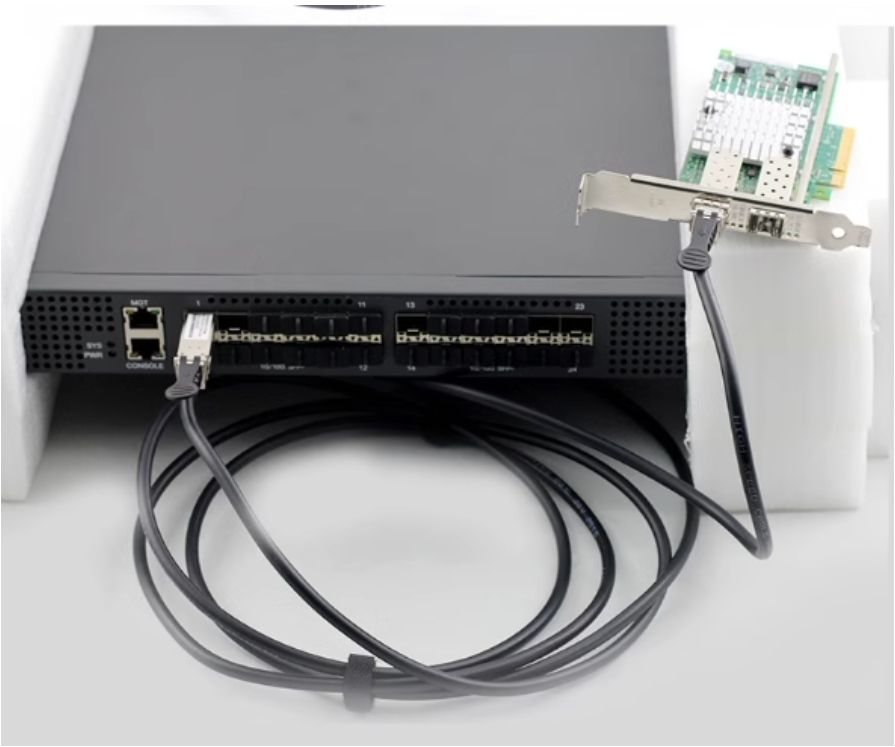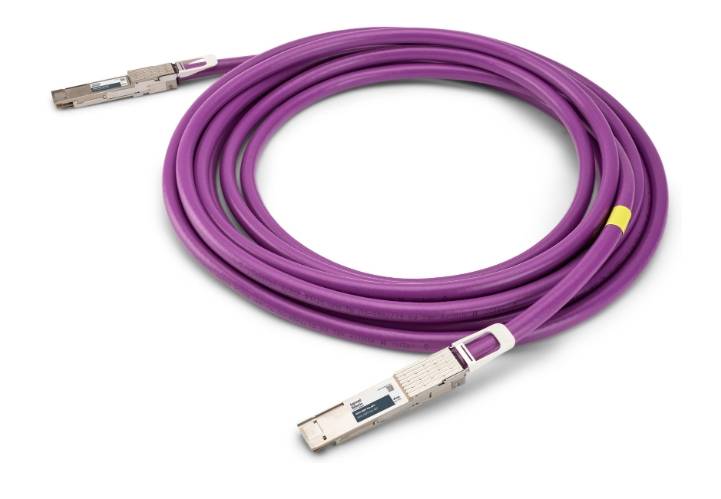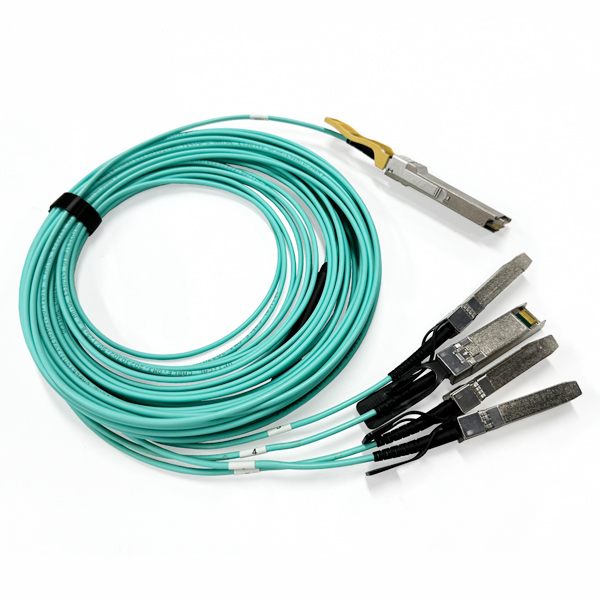Today, the communications industry is in high competition, everyone expects to gain a competitive advantage, whether in terms of performance, efficiency or cost. While many data center renovations focus on network adapter and switch configurations, there is an extremely basic, but equally effective way to improve deployed data centers, which is to rethink interconnect cables. There are currently four different forms of data transmission cables on the market, namely: DAC (Direct Attach Cable), AOC (Active Optical Cable), AEC (Active Electrical Cable) and ACC (Active Copper Cable), which differ in transmission media, performance characteristics and application scenarios.

Below we will learn about DAC, AEC, AOC, ACC and check which is best in the field of data communication?
| Type | DAC | AEC | Optical communication solution(AOC) |
| Speed | ≤400G | The highest mass-produced product currently reaches 1.6T | The highest mass-produced product currently reaches 800G |
| Transmission rate | <7 meters | <7 meters | Can support long-distance transmission, the mainstream product SR in the data center supports 300-meter transmission, and DR supports 500-meter transmission |
| Outer diameter | Large, 400G 2.5 meters is 11mm | Smaller, 400G3 meters is 6.8mm | Small, 400G is only 3mm |
| Space occupied | Large, 400G is 4 times that of AEC solution | Smaller | Small, 400G is 1/4 of AEC |
| Cost | Low, 400G is about half of AEC | Lower | High, 400G is about 2 times of AEC solution |
| Power consumption | Low, 400G is less than 1/4 of AEC | Medium | High, 400G is about 2 times of AEC solution |
DAC Cable (direct attach cable)
Technical principle
DAC Direct Attach Cable is direct copper wire with optical transceivers. It is usually purchased in fixed length and has fixed connectors at both ends. The port cannot be replaced, and the module head and copper cable cannot be separated. High-speed cable is accepted by more and more users for its significant advantages such as high cost performance, high efficiency, high speed, high composite and low loss. It has become the first choice for high-speed data communication solutions and is widely used in storage area networks, data centers and high-performance computer connections within rack.
The basic structure of DAC cable
DAC cable mainly composed of silver-plated conductors and core wires made of foam insulation, Teflon, and PP, and then using line pair shielding and overall shielding to form high-speed cables. High speed cables have excellent attenuation performance, low latency, and anti-interference, and can achieve high-frequency broadband transmission. There are 32AWG ~ 24AWG specifications and 2P, 4P, 8P or 16P and other structures, which can be used in a variety of different applications.
Advantages of SFP DAC cables
DAC twinax cable has become the preferred solution for users in short-distance application and is widely used in data center interconnection scenarios such as SATA storage devices, RADI system scenarios, core routers, 10G or 40G Ethernet, etc. In data centers, copper cables are generally used to connect servers and storage area networks. Since passive copper cables are cheap and have fast transmission speeds, they have become the best solution for short-distance transmission within 7meters.
High performance: suitable for short distance wiring in data centers, with a wide range of applications and strong integrated solution switching capabilities.
Energy-saving and environmental protection: The internal material of cable direct attach is copper core, and the natural heat dissipation effect of copper cables is good, which is energy-saving and environmentally friendly.
Low power consumption: direct copper attach cable have low power consumption. Since passive cables do not require power; active cables generally consume about 440mW.
Low cost: The price of copper cables is much lower than that of optical fibers. Using DAC ethernet cable can greatly reduce the wiring cost of the entire data center.
The transmission rates and package types supported by AOC active optical cables include 10G SFP+, 25G SFP28, 40G QSFP+, 100G QSFP28, 200G QSFP-DD, 400G OSFP, 800G OSFP, 400G QSFP DD and 800G QSFP-DD.

AEC Active Electrical Cable
Technical principle:
Active electrical cables, by adding CDR (clock data recovery) and Retimer chip architecture at both ends of the cable, not only amplify and balance the transmission signal, but also reshape the signal, thereby extending the transmission distance. Suitable for application scenarios that require long distance, low power consumption and compact design.
Basic structure of AEC cable
AEC cable is made mainly from silver-plated conductors and Teflon insulation material core wires, and then using line pair shielding and total shielding to form high-speed cables. It have excellent attenuation performance, low latency and anti-interference, and can achieve high-frequency broadband transmission. There are 28~24AWG specifications and 8P, 16P and other structures, which can be used in a variety of different applications.
Advantages of AEC active cables
AEC active cables are released by the HiWire Alliance. The HiWire AEC specification defines the standards for basic electrical and mechanical specifications. AEC active cables support transmission rates of 100G, 200G, and 400G. The package types include QSFP56, OSFP, and QSFP-DD. The longest transmission distance can reach 7 meters. It has forward error correction (FEC) function and cable retiming function to ensure fully balanced signals with ultra-low bit error rates.
AEC active cable is a key enabling technology for DDC (distributed chassis) architecture, which overcomes the density, weight and performance limitations of copper cable DACs and the cost and availability of AOCs. Its advantages are low power consumption, low cost, and space saving. Among them, the power consumption is 25% lower than that of optical devices, the cost is 50% lower than that of optical components, the volume is smaller than DAC, and it can save up to 70% of space compared to DAC, and it is more reliable than optics.
AEC active cables are mainly used for connecting ToR to servers and distributed chassis, with up to 500 cables per rack.
Applicable to application scenarios that require long-distance transmission, low power consumption and compact design, such as interconnection needs of distributed data centers, telecommunications and enterprise markets
Power consumption: AOC and AEC have lower power consumption than DAC, which helps reduce overall system energy consumption.
Transmission distance: DAC has a limited transmission distance, usually within 5 meters; AEC can extend the transmission distance to longer application scenarios through signal enhancement technology.
Price: AOC is more expensive because it contains lasers and optical fibers; DAC and AEC are relatively cheap and suitable for large-scale applications.
Size and weight: AOC and AEC are smaller in size and weight than DAC, and are more suitable for space-constrained application scenarios.

AOC Active Optical Cable
Technical principle:
AOC active optical cable refers to a communication cable that needs external energy to convert electrical signals into optical signals, or optical signals into electrical signals during the communication process. The optical transceivers at both ends of the optical cable provide photoelectric conversion and optical transmission functions. It looks similar to copper cable. AOC uses one optical cable to connect two high-density connectors. AOC contains a laser inside, which is more expensive, but has superior transmission performance.
Basic structure of AOC cable
Depending on different application scenarios and requirements, the detailed structure and components of AOC cables may vary. For example, some active fiber cables may also contain other auxiliary devices, such as optical amplifiers and optical attenuators, to optimize signal transmission and ensure system stability. In summary, the basic structure of active optical network cables is composed of optical fibers, photoelectric converters, and connectors.
Advantages of active optical cable aoc
First, it is much lighter than the other two types of high-speed cables;
secondly, since optical fiber is a dielectric, it is not easily affected by electromagnetic interference and is suitable for applications with long distance and high reliability requirements, such as connections between core switches and long-distance transmission within data centers.
The disadvantages of SFP cable AOC are also obvious.
Compared with high-speed cables, active optical cables are more expensive. The laser life of AOC cables is generally 3-5 years, and it is difficult to repair. As a new type of transmission optical cable, active optical cables need external energy to convert electrical signals into optical signals or optical signals into electrical signals during the communication process. The loss in the conversion process and the heat loss generated are an important reason why AOC is difficult to popularize. However, many people in the market believe that AOC active optical cable assembly have a longer transmission distance and reduce electromagnetic interference, so its advent has brought about this misunderstanding: all aspects of the network should adopt this newer technology.
The transmission rates and package types supported by AOC active optical cables include 10G SFP+, 25G SFP28, 40G QSFP+, 100G QSFP28, 200G QSFP-DD, 400G OSFP, 800G OSFP, 400G QSFP DD and 800G QSFP-DD.

ACC Active Copper Cable
Technical principle:
ACC is active copper cable, which is a technology that adds a linear redriver with a certain capacity at the receiving end (Rx end) of the cable to provide signal equalization and shaping. It uses chips to compensate for the high-frequency loss of the passive copper cable DAC, which is more like an active cable that amplifies the pseudo signal. It extends the transmission distance of traditional copper cables to a longer range of application scenarios. ACC can also be used to connect TOR and servers. It provides a cost-effective way for short links, thereby providing greater bandwidth transmission. The ACC transmission distance can exceed 3m in high-speed transmission. It is very important to choose the right cable length because it can be a key variable in overall performance.
The transmission rates and package types supported by ACC active copper cables include 10G SFP+, 25G SFP28, 40G QSFP+, 50G QSFP+, 100G QSFP28, 200G QSFP-DD, 400G OSFP, 800G OSFP, 400G QSFP DD and 800G QSFP-DD.
ACC is mainly used in scenarios where signal amplification and reduction are required. The transmission distance is relatively short and it does not have repair and reorganization functions. The market space is small, but it is still used in some cost-sensitive scenarios with low transmission distance requirements.
The transmission rates and package types supported by ACC active copper cables include 10G SFP+, 25G SFP28, 40G QSFP+, 50G QSFP+, 100G QSFP28, 200G QSFP-DD, 400G OSFP, 800G OSFP, 400G QSFP DD and 800G QSFP-DD.
ACC is mainly used in scenarios where signal amplification and reduction are required. The transmission distance is relatively short and it does not have repair and reorganization functions. The market space is small, but it is still used in some cost-sensitive scenarios with low transmission distance requirements.
Conclusion
When selecting data transmission cables, comprehensive consideration should be given to factors such as specific application requirements, transmission distance, cost budget, and space constraints. In the field of data communications, we see the emergence of Ethernet application trends, and ACC is expected to expand from Infiniband to Ethernet applications. We believe that the upgrade of switch speed is also expected to drive changes in the high-speed connection mode of data centers, and new products such as AEC and ACC are expected to expand downstream customers.
The emergence of higher-speed switches is expected to drive port rate upgrades. Traditional copper cable DACs are prone to huge signal loss and attenuation at high speeds. To compensate for signal attenuation, the diameter of DACs needs to be continuously increased. According to Amazon, the outer diameter of a 100G DAC supporting 2.5-meter transmission is 6.7 mm, while the outer diameter of a 400G DAC supporting 2.5-meter transmission is 11 mm, making it difficult for cloud vendors to arrange data cables.
In addition, the larger outer diameter of DAC also means a larger bending radius, which makes the entire rack occupy a larger area and use more space. The current innovative solution for high-speed copper connections is active cable AEC.
Compared with DAC, AEC adds chips at both ends of the copper cable to perform signal recovery, which can reduce the loss and attenuation of high-speed signals during copper wire transmission. Therefore, the outer diameter of AEC is smaller than that of traditional DAC, and the space occupied is also lower. In the construction of large-scale AI clusters, we believe that since the interconnection density of AI clusters is significantly higher than that of cloud computing, AEC has a smaller outer diameter and is more suitable for large-scale networking wiring.
In addition, in short-distance transmission, compared with optical communication solutions using optical modules and optical fibers, AEC has the advantages of low cost, low energy consumption, and low maintenance cost in short-distance transmission. According to Credo’s calculations, the comprehensive cost of 400G AEC can be reduced by 53% compared to the AOC solution. We believe that as the transmission rate of data center networks continues to increase in the future, DAC will face greater difficulties in short-distance transmission, and innovative connection methods such as AEC are expected to replace DAC. According to Yindga calculations in December 23, the AOC, DAC, and AEC markets will be US$1.2 billion in 23 and are expected to reach US$2.8 billion in 2028, of which the CAGR of the AOC, DAC, and AEC markets from 23 to 28 will be 15%, 25%, and 45%, respectively.


